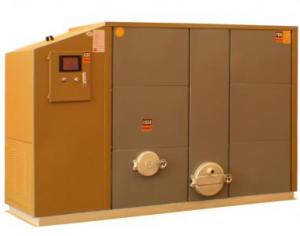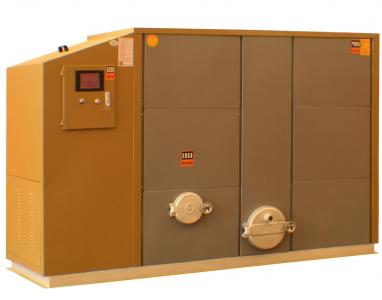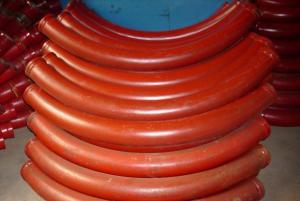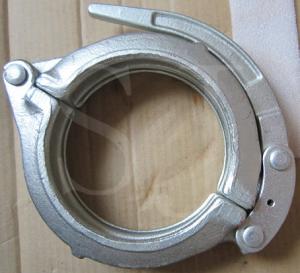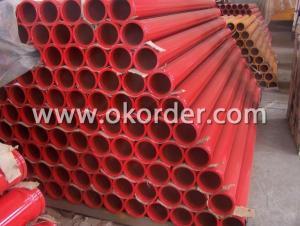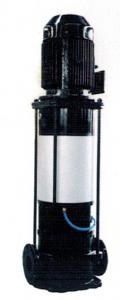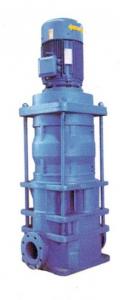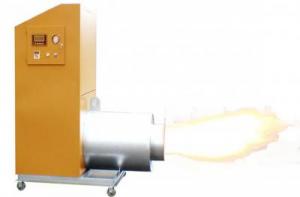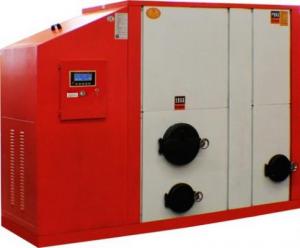HUAYUAN high-end horizontal biomass boiler--349KW
OKorder Service Pledge
OKorder Financial Service
You Might Also Like
This boiler is 349KW one.
Introduction:
The first horizontal biomass boiler in China Brand: HUAYUAN
High-end product---Longxiao series A, B, C
Technical features:
By the great effort, HUAYUAN has developed the first biomass boiler without grate. There are three kinds of hot water boilers as following:
Longxiao Series A: blue touchscreen control system, burning any biomass fuel without dark smoke.
Longxiao Series B: colorful touchscreen control system. motor frequency control system. drain the coked fuel in the combustion procession. burning all coked biomass fuel.
Longxiao Series C: large colorful touchscreen control system. intelligent control system, internet control system. drain the coked fuel in the combustion. burning all coked biomass fuel.
Characteristics:
1. Different from tradition vertical boiler, any parts of boiler could be checked and repaired. Even the fire pipes in the boiler could be replaced without boiler disassembled.
2. HUAYUAN adopts world leading patent combustion system. Boilers without grate will need no more grate transporting to solve coked fuel burning problem.
3. High temperature in the hearth could be controlled to make sure that temperature is enough high to do biomass pyrolysis gasification and complete combustion. With specially designed
airflow spraying, tar will not be attached to the hearth after longtime combustion and pipes will not be blocked by the attached tar, it will do little effect on the boiler's efficiency after long time using, this is what users will neglect. Long-time energy saving is what matters.
4. As store is directly connected to the hearth, many biomass boilers catch fire easily. Applying anti-back fire structure and back-flow prevention device, so that only biomass fuel can be put into hearth, high temperature airflow can't flow into bunker. We are equipped with safety fire protection device, even when the back-flow prevention device fails, automatic monitoring feeding system will start to force high temperature into hearth. Boiler will stop working only after cleaning all the fuels.
5. Change the traditional boiler feeding way, decrease the feeding height of bunker, increase the capacity, reduce the labor strength.
6. Traditional biomass boiler only monitor output water temperature, Longxiao series adopts touchscreen control system, clients can monitor the parameters of temperature of input water, output water, smoke, fuels in bunker, combustion in hearth etc. After the change of relevant data, it will timely remind the user of maintenance, so that to allow user to get more information about running status and energy-saving data.
7. First one to apply internet control system in biomass fuel industry, you can monitor the boiler everywhere with internet.
8. Under intelligent control, boiler will automatically operates from start-running-stop-restart. You could be an online boiler operator with high efficiency and 6 safety protection settings.
Product specification: covers from 10*104Kcal~180*104Kcal (this list shows parts of specifications for reference)
Item | Unit | CLHS0.12 | CHLS0.24 | CLHS0.35 | CHLS0.48 | CLHS0.60 | CLHS0.73 | ||||||
Rated head | Kcal | 10*104 | 20*104 | 30*104 | 40*104 | 50*104 | 60*104 | ||||||
Rated discharge pressure | Mpa | 0(Normal pressu re) | |||||||||||
Rated temperature of outlet water | ℃ | 85 | |||||||||||
Rated temperature of return water | ℃ | 60 | |||||||||||
Heat efficiency | % | 90 | |||||||||||
Water inlet | MM | 40 | 50 | 50 | 65 | 65 | 80 | ||||||
Water outlet | MM | 40 | 50 | 50 | 65 | 65 | 80 | ||||||
Drain hole | MM | 40 | 50 | 50 | 65 | 65 | 80 | ||||||
Vent hole | MM | 40 | 50 | 50 | 65 | 65 | 80 | ||||||
electricity | KW | 1.1 | 1.5 | 1.8 | 2.2 | 2.7 | 3.2 | ||||||
size | length | MM | 2060 | 2360 | 2560 | 2790 | 2820 | 3200 | |||||
width | MM | 650 | 738 | 850 | 1010 | 1060 | 1150 | ||||||
height | MM | 1760 | 1760 | 1760 | 1960 | 1960 | 1960 | ||||||
- Q: C'mon, I know there are people out there who have gone temporarity insane from love.
- Ohhh nooo, I am not falling for this one...ok, maybe I am. But it doesn't involve bunny boiling at all...it actually involves no very lady like behavior, that fortunately was prevented by two very wise friends... I caught one of my friends trying to seduce my ex boyfriend...she was stroking his leg with her leg, and instead of going after him first I was about to hit the girl...stupid stupid, but then again I was 18 and had had a couple of tequila shots. Either way, one of my friends grabbed me by the arm and gently took me aside at the bar we were at (remember in Mexico it is legal to be at bars by 18) and explained that such conduct wasn't very lady like and that I should just not do anything. Next day in gym class, I passed a note to my friend and she never did anything of the sort again...a couple of months later I broke up with that boyfriend...and then we were on and of again for five years...whew...
- Q: I asked this question once already, but I guess I didn't give enough info, so I am going to try this again. Bare with me because I honestly don't know anything about this, that is why I'm trying to get info on here. I am currently looking at buying a house that is heated with a boiler furnace. There are base board vents through out the house, and multiple thermostats to control the heating in the different zones of the house. I'm not sure if this also controls the hot water, or if there is a seperate hot water heater. My understanding is that there are lines that run along the base boards, hot water runs through them and some how heats the house?!?! Like I said, I really don't know, and I am just trying to get a better understanding of this system. ANY info on them would be much appriciated, such as cost to replace them, repair them, or service them. Common problems to watch out for, how they opperate, and if it would be better than a regular furnace.
- I can't tell from your description whether your system is hot water or steam. Usually, with baseboard radiators, it is hot water which means you do not have a boiler, just a hot water furnace. It is heated by burning either natural gas or oil. The baseboard units radiate the heat carried by the water into the room. Each baseboard should have isolation valves and a small vent (operated by a key). You should bleed any air out of each radiator by opening the vent allowing any air to escape until water comes out of the vent. Start on the lower floors and work your way up to the upper floors of the house. Bleeding the air will maximize the efficiency. If you don't get water out, the system needs to have water added. Look for a supply valve near the heater. This heating system may or may not have a separate water heater for non-heating purposes (bath, laundry, kitchen etc.). Take a trip to your basement and get familiar with system. Get your gas or oil supplier or a plumber to walk you through the piping and valves.
- Q: how much is a gas boiler for a single family home with installation??
- This would be entirely dependent on the size of the house, which is the controlling factor for the size of the boiler, and difficulty of installation. Call a local business and get a free quote. In fact, why don't you get three so you can compare!
- Q: Plz explain the difference and applications for both boiler.If any pictures available means kindly send .in
- There are fire tube boilers where the products of combustion travel through the tubes to heat the water. These are sometime called Scotch marine boiler. There are tube type boilers where the water is in the tubes but the tubes are connected at top and bottom by drums. The bottom drum is called the mud drum and the top is the steam drum where the water level in the boiler is maintained and the steam is separated from the water. The coil type boiler is a special version of the water tube boiler in that the tubes are formed in a spiral. The links below will give some additional information.
- Q: The structure of the boiler
- The main parts of the boiler, such as the furnace, the drum, the burner, the water wall, the superheater, the economizer, the air preheater, the structure and the furnace wall, constitute the core part of the production steam, called the boiler body.
- Q: We are looking to replace our existing Worcester combi boiler (about 10 years old) with a newer condenser model. Two of the quotes that we received mentioned that the diameter of our gas pipework may not be sufficient.So my question is: is this correct? Our flat is fairly small (5 radiators) and the existing combi boiler works fine with this pipework, leading me to think that this may be a bit of a con. It wasn't mentioned by any of the other plumbers who quoted us, either.It would be a royal pain to change the pipework, as it is a listed building, and the pipework itself can be no more than 12 years old, as this was when the building was converted to residential dwellings.Thanks,JP
- Decide what boiler u want then check gas inlet to it All boilers will show that info. on the owners manual if not on it.(Name plate)
- Q: in a bio mass power plant
- The need for continuous blow down in any boiler is due to the fact that no steam system is 100% closed. There are always losses of steam from valve packing, flanges, turbine packing or seals, etc. Over a period of time the amount of water in the system would be depleted to the point that the boiler could not function. To counter this, water is added usually on a continuous basis. Since this water is never 100% pure there is, over time, a build up of chemicals in the the system. To deal with pH, oxygen in the system, etc, treatment chemicals are also added. To keep the chemistry in the right range, as water is added, some of the boiler water is removed as blowdown. You can do this on a batch basis but it is usually better for the system to do it on a continuous basis so the boiler water stays closer to the desired chemical balance.
- Q: I have a gas boiler and water baseboard heater ,The boiler would turn on for about 5min then turn off even though it has not reach the tempature on the thermostat I notice that the overflow valve leaks , my psi is at about 15 ,temperature on the boiler is about 80-85.I also can hear a small humming noise coming from the return pipe .what can this be...
- If your system has and expansion tank it may have become water logged and hydrostaticly full. When the burner trys to heat the water in the boiler, the water has no place to expand, and.the pressure builds up and the pressure switch on the boiler turns off the boiler prematurely as if it was up to heat. Your relief valve is probably set for 30 lbs but has been building and relieving at each try for heat due to the hydrostatic pressure in your system, If your Expansion tank has a bladder, charge the bladder with a bit of air. If it is a tank only then Isolate the tank from the system with a hand valve, drain the tank to empty while opening a vent on it to let air into the tank.. Close of the drain and the vent and re-open the hand valve to the system. The system will flood water back into the tank but the air cushion will be captured in the top of the tank. Now when firing it will have a space of air to expand to. Hope this helps.
- Q: I've installed a low mass direct vent oil burning boiler (140Kbtu) by LAARS a year ago and twice this year it sooted up so much that it choked itself to the point of burning terribly rich. (thick black smoke out the flue) I'm wondering if it could be my oil, I never had this issue until the last delivery. (This is my second season with this boiler...) I also wonder if using too small of a nozzle can cause this. I'm currently using a .65gph nozzle due to my heating load being relatively small. (Only half of my house is currently on the boiler, I wanted to prevent short cycling the burner.) I opened the fire box and totally cleaned everything from the opening of the flue, clear through all of the internal baffles in the boiler to the intake air line. It was incredibly clogged with soot. Now about a month later, it appears to be in the beginning stages of sooting up again. This morning the boiler locked out, but restarted with ease... but I noticed the black smoke out of the flue again.
- maybe ur venting needs cleaning or bad fuel oil
- Q: we have 3 boiler in low load in a petrochmical company how we can have a steam load sheding?
- Boilers do not operate well at low loads, you should take one, or two, out of service. .
Send your message to us
HUAYUAN high-end horizontal biomass boiler--349KW
OKorder Service Pledge
OKorder Financial Service
Similar products
Hot products
Hot Searches
Related keywords
